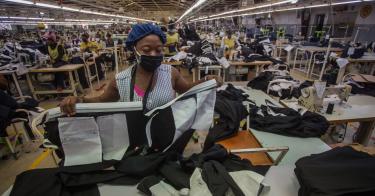As a group of American apparel companies noted in a letter last month to U.S. Trade Representative Robert Lighthizer, the Caribbean Basin Trade Partnership Act expires at the end of this month.
As the letter to Lighthizer noted, Haiti is one of the biggest beneficiaries of programs operating under the act, and extending the act beyond Sept. 30 would be beneficial for both Haiti and the United States.
The Caribbean Basin Trade Partnership Act, as described in this report by the U.S. Customs and Border Protection agency, provides duty-free and quota-free access for apparel made in eligible countries, as long as the fabrics are made and cut in the United States. It builds on a larger trade preference program, the Caribbean Basin Economic Recovery Act, which has been in place since 1983 and has no expiration date.
The Haitian Hemispheric Opportunity through Partnership Encouragement Act and the Haiti Economic Lift Program Act operate in concert with the Caribbean Basin Trade Partnership Act.
Together, the American textiles manufactured as part of the program helped make possible U.S. exports to Haiti, which totaled about $6 billion cumulatively in the years from 2014 through 2018.
They have also supported many jobs for American workers, incentivized private sector-led economic development in the region, including investment in the Haitian economy that has helped to reduce extreme poverty, and advanced other important U.S. foreign policy goals.
President George W. Bush signed the Haitian Hemispheric Opportunity through Partnership Encouragement Act into law in 2006, and the Haiti Economic Lift Program Act was passed during the administration of President Barack Obama.
According to the World Bank, Haiti’s export sector accounted for 16.9% of its gross domestic product in 2019. Statista reports that Haiti’s GDP in 2019 was $20.8 billion; so, exports represented $3.5 billion of the economy, and exports through the Haitian Hemispheric Opportunity through Partnership Encouragement Act alone accounted for more than 10% of that total.
For the 12 months ending in May, the Department of Commerce reports that U.S. companies had imported $363.7 million worth of Haitian-made products covered by the latter act.
Those products, in turn, supported textile jobs in the U.S., where the fabric is made and cut prior to export to Haiti.
Adopting policies to boost the private sector in Haiti could also help the country improve its score in the annual Heritage Foundation Index of Economic Freedom. Haiti’s economic freedom score in 2020 is 52.3, making its economy the 153rd-freest of 180 worldwide in the 2020 index. The country is ranked 27th among 32 countries in the Americas region, and its overall score is well below the regional and world averages.
Unfortunately, the Haitian economy has been sliding backwards in the index’s ranks of mostly unfree countries. Without the opportunities provided under the Caribbean Basin Trade Partnership Act and the other related programs, it risks a return to the bottom of the index, the repressed category from which Haiti only emerged in 2018.
Although Haiti also continues to benefit from infrastructure projects funded by the World Bank and the Inter-American Development Bank, only private sector-led economic growth through the production of value-added and marketable products can help the country achieve sustainable and long-term development.
Haiti is the poorest country in the Western Hemisphere. Its economic health and political stability have long been of concern to successive U.S. administrations.
Taking the relatively inexpensive step of continuing U.S. aid to Haiti’s textile sector will have benefits for both countries.
This piece originally appeared in The Daily Signal



